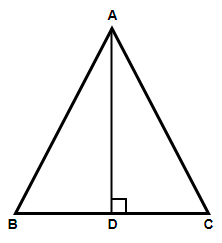
What is the hypotenuse – leg theorem?
Answer
515.1k+ views
Hint: First of all we will understand the hypotenuse – leg theorem and what it is used for. Now, we will take examples of two right angle triangles with some of the given assumptions and we will try to prove them congruent using the hypotenuse – leg theorem. Also we will see its relation with R.H.S congruence criteria.
Complete answer:
Here we are asked to describe the hypotenuse – leg theorem. So, we need to understand the statement of the theorem and then we need to see its use.
Now, the hypotenuse – leg theorem is used to prove if two given right angle triangles are congruent or not. The theorem states that ‘if the hypotenuse and one side of a right angle triangle is equal to the hypotenuse and one side of the other triangle then the two right angle triangles are congruent to each other’.
Let us consider an example: - here we are assuming an isosceles triangle ABC with sides AB = AC, we draw a perpendicular AD from the vertex A to the side BC. We need to prove that the right triangles ABD and ACD are congruent.

Now, in right triangles ABD with ACD we have,
AB = AC (triangle ABC is isosceles)
AD =AD (common side)
Clearly we can see that AB is the hypotenuse of triangle ABD and similarly AC is the hypotenuse of the triangle ACD while AD is the side common in them. So we can say that the hypotenuse and one side of triangle ABD is equal to the hypotenuse and the other side of the triangle ACD. Therefore, the two right triangles are congruent by the hypotenuse – leg theorem.
Note: Note that the hypotenuse – leg theorem is also called the R.H.S congruence criteria. R.H.S is a congruence criteria in which R, H and S stands for right angle, hypotenuse and side respectively. It is used to prove two triangles congruent when they have a right angle, their hypotenuses are of equal length and one of the remaining two sides are also equal.
Complete answer:
Here we are asked to describe the hypotenuse – leg theorem. So, we need to understand the statement of the theorem and then we need to see its use.
Now, the hypotenuse – leg theorem is used to prove if two given right angle triangles are congruent or not. The theorem states that ‘if the hypotenuse and one side of a right angle triangle is equal to the hypotenuse and one side of the other triangle then the two right angle triangles are congruent to each other’.
Let us consider an example: - here we are assuming an isosceles triangle ABC with sides AB = AC, we draw a perpendicular AD from the vertex A to the side BC. We need to prove that the right triangles ABD and ACD are congruent.

Now, in right triangles ABD with ACD we have,
AB = AC (triangle ABC is isosceles)
AD =AD (common side)
Clearly we can see that AB is the hypotenuse of triangle ABD and similarly AC is the hypotenuse of the triangle ACD while AD is the side common in them. So we can say that the hypotenuse and one side of triangle ABD is equal to the hypotenuse and the other side of the triangle ACD. Therefore, the two right triangles are congruent by the hypotenuse – leg theorem.
Note: Note that the hypotenuse – leg theorem is also called the R.H.S congruence criteria. R.H.S is a congruence criteria in which R, H and S stands for right angle, hypotenuse and side respectively. It is used to prove two triangles congruent when they have a right angle, their hypotenuses are of equal length and one of the remaining two sides are also equal.
Recently Updated Pages
Master Class 10 Computer Science: Engaging Questions & Answers for Success

Master Class 10 General Knowledge: Engaging Questions & Answers for Success

Master Class 10 English: Engaging Questions & Answers for Success

Master Class 10 Social Science: Engaging Questions & Answers for Success

Master Class 10 Maths: Engaging Questions & Answers for Success

Master Class 10 Science: Engaging Questions & Answers for Success

Trending doubts
Why is there a time difference of about 5 hours between class 10 social science CBSE

Write a letter to the principal requesting him to grant class 10 english CBSE

What is the median of the first 10 natural numbers class 10 maths CBSE

The Equation xxx + 2 is Satisfied when x is Equal to Class 10 Maths

Which of the following does not have a fundamental class 10 physics CBSE

State and prove converse of BPT Basic Proportionality class 10 maths CBSE




